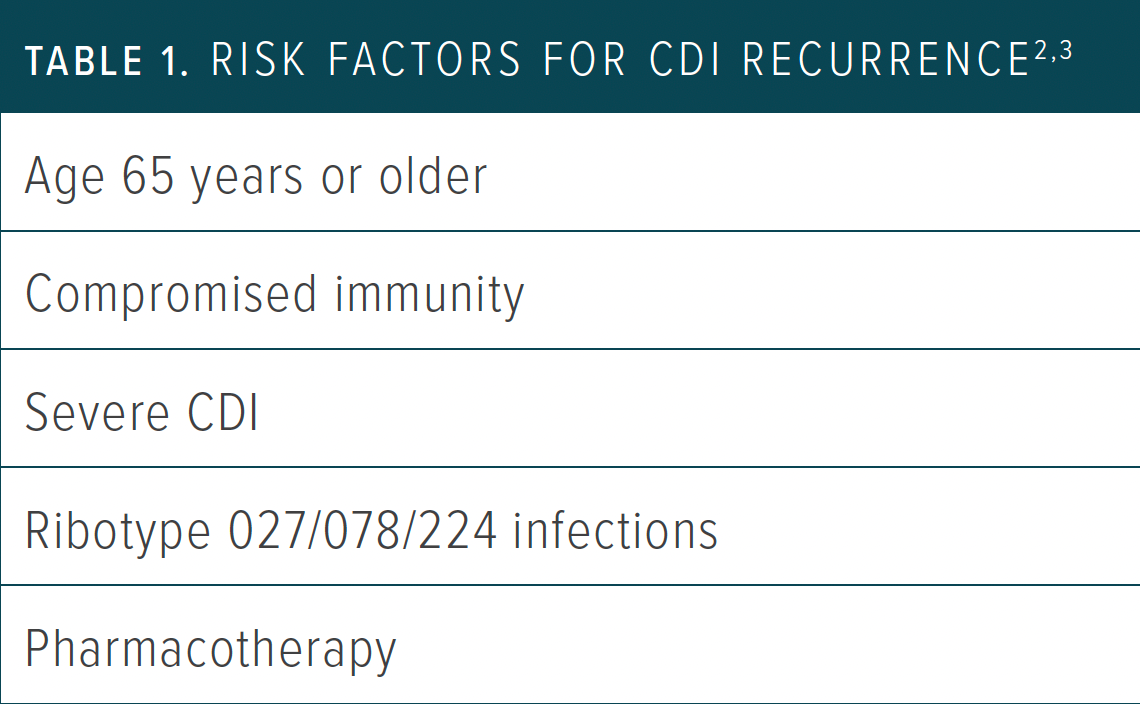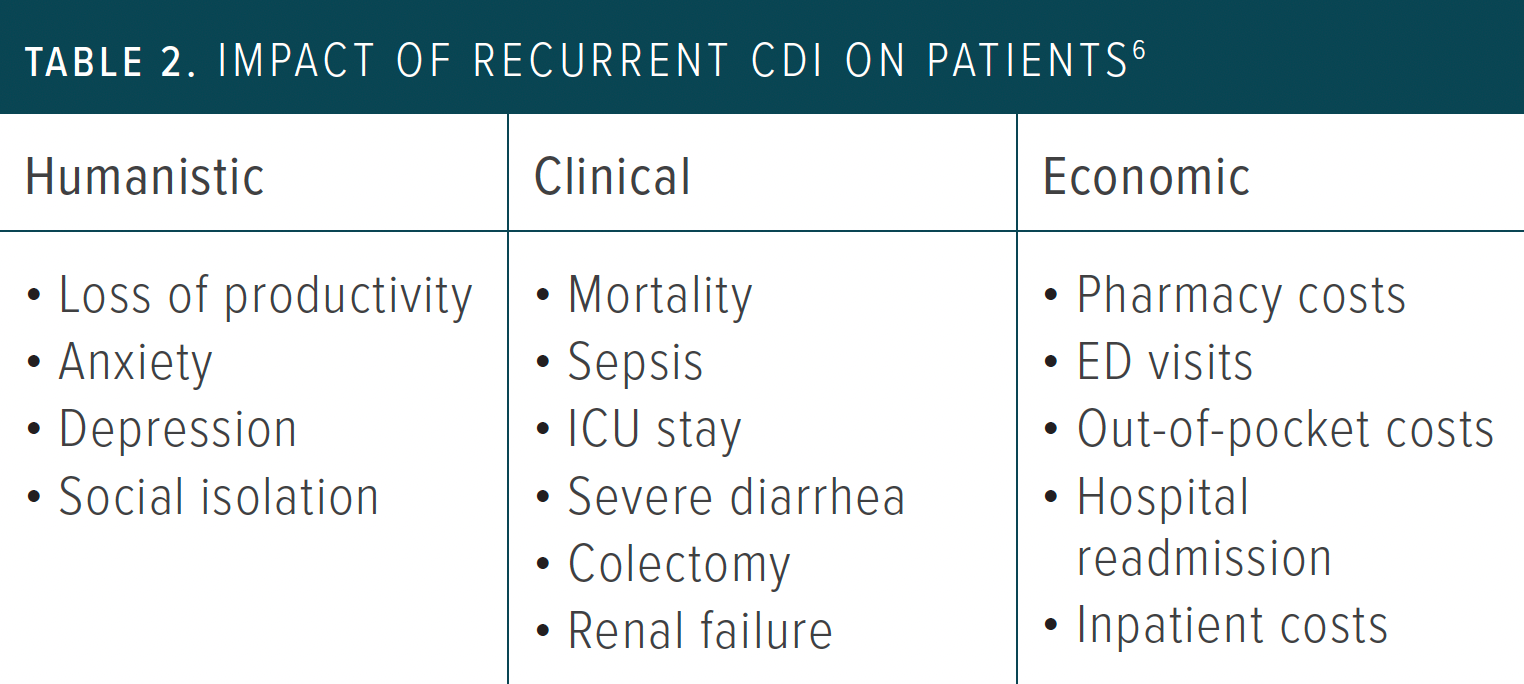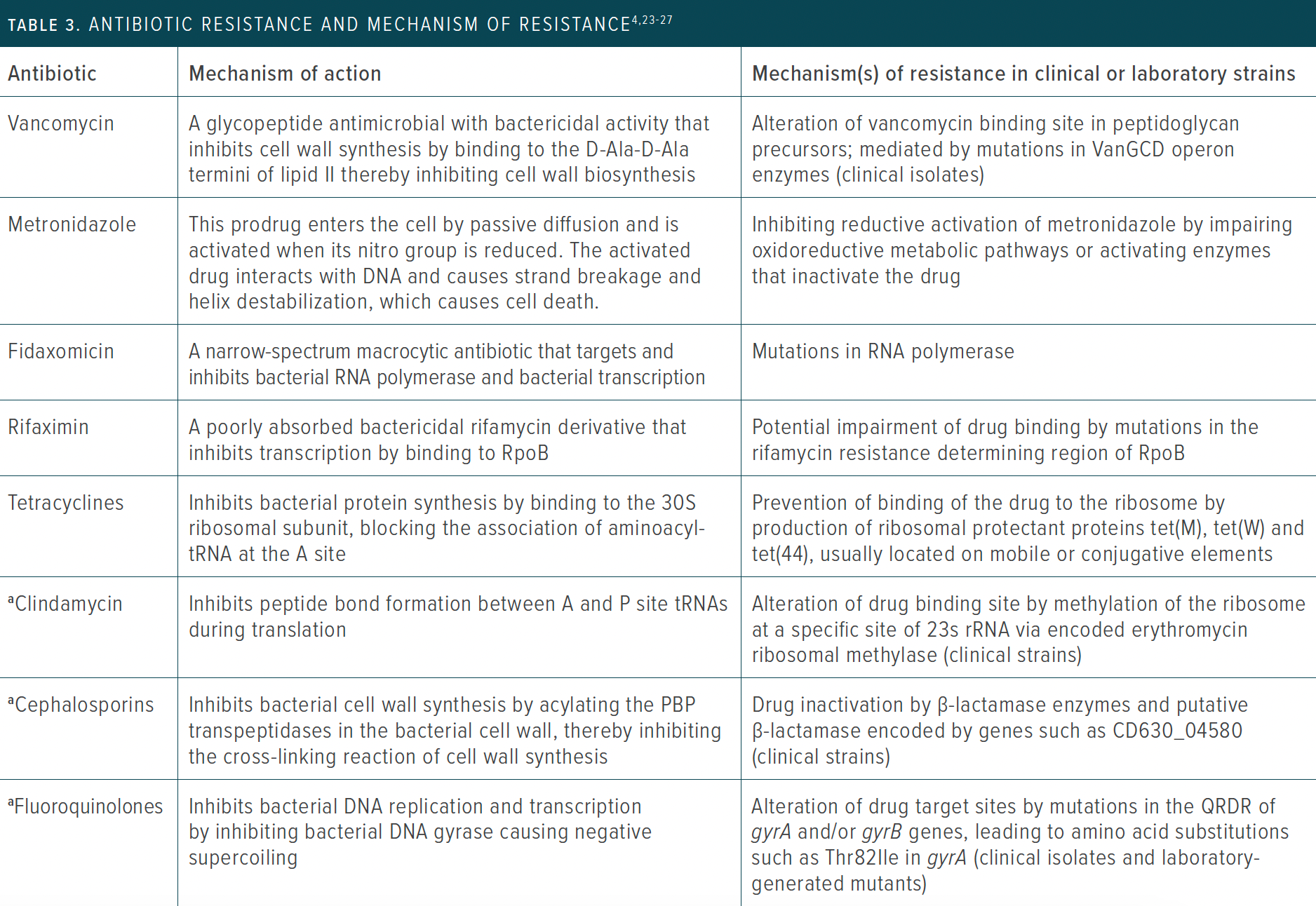Publication
Article
Pharmacy Practice in Focus: Health Systems
Managing Recurrent C difficile Infections: Past, Present, and Future
Since 2000, as the number of CDIs has surged, morbidity and mortality also have increased.
Clostridioides difficile is a gram-positive, spore-forming bacterium found naturally in the environment.1 Human gastrointestinal tracts often carry C difficile asymptomatically, and a healthy microbiota defends against the proliferation of C difficile. However, a common risk factor linked to C difficile infection (CDI) is the use of broad-spectrum antibiotics that alter the gut microbiota. Additional risk factors are summarized in Table 1.2,3
Table 1: Risk factors for CDI recurrence | CDI, Clostridioides difficile infection.

CDI is the leading cause of hospital-acquired diarrhea, particularly among patients 65 years or older. Individuals who are hospitalized or reside in institutional settings have higher rates of C difficile, irrespective of diarrheal symptoms.4 The primary treatments for CDI are vancomycin (Vancocin; ANI Pharmaceuticals), metronidazole, and fidaxomicin (Dificid; Merck); treatment recurrence may occur in approximately 20% of patients.4,5 Since 2000, there has been a rise in incidence of CDI with increased morbidity and mortality, which have been linked to the spread of more virulent epidemic strains, such as ribotype (RT) 027 (North American Pulsed-Field [NAP] type NAP1), that have spread around the world.6
In hosts with antibiotic-induced reductions in microbial diversity, C difficile spores germinate into the vegetative cells and subsequently produce 2 exotoxins known as toxin A (TcdA) and toxin B (TcdB), which are responsible for the pathogenicity of CDI; both toxins are located on the pathogenicity locus.7 Once released in the colon, TcdA and TcdB latch onto receptors on host cells and are engulfed into the cells through endocytosis. They disable Rho family GTPases inside the cell by adding a glucose molecule (glucosylation), leading to their inactivation.8 This disrupts the typical structure of the host cell’s cytoskeleton and deteriorates the protective epithelial barrier. This tissue damage induces an inflammatory response resulting in C difficile–associated diarrhea and colitis.7
Transmission
C difficile is transmitted by its spores in the environment and via the fecal-oral route. Notably, alcohol is not effective at eliminating C difficile spores in the environment. C difficile spores can survive on surfaces that are in contact with contaminated feces for long periods. Infection can occur if an individual touches contaminated surfaces or objects and then ingests the bacteria.
C difficile spores spread easily in health care environments due to the proximity of patients, frequent contact with health care workers, and use of antibiotics. Moreover, there appears to be a rise in community-acquired CDIs, which may not be connected to a recent hospitalization or the use of antibiotics.9
Symptoms
Clinical manifestations of CDI can include mild to moderate diarrhea, toxic megacolon, pseudomembranous colitis, and even death.10 C difficile toxin-mediated damage leads to a neutrophil-mediated inflammatory response, which is a hallmark of the disease.11 Mild diarrhea with mild abdominal cramping and tenderness may progress to more profuse diarrhea, severe abdominal pain, loss of appetite, fever, and dehydration. Beyond the physical discomfort and health risks associated with the infection itself, the recurrent nature of the disease often leads to a cycle of debilitating symptoms, frequent hospitalizations, and a significant reduction in quality of life (Table 26). However, some patients infected with C difficile remain asymptomatic, which may pose a transmission risk to others because asymptomatic carriers may act as a reservoir for spores.4
Table 2: Impact of recurrent CDI on patients | CDI, Clostridioides difficile infection; ED, emergency department; ICU, intensive care unit.

Diagnosis of CDI
Diagnosing CDI requires the presence of diarrhea, which is defined as having 3 or more unformed stools in 24 hours and a positive stool test for toxigenic C difficile or its toxins. Laboratory tests to diagnose CDI include glutamate dehydrogenase (GDH), toxin enzyme immunoassay (EIA), and toxin B polymerase chain reaction (PCR). GDH and toxin B PCR are used as screening tests, and toxin EIA is used to confirm diagnosis.12,13
Counseling Points for Prevention of C difficile
Pharmacists can counsel patients with CDI on the importance of washing their hands with soap and warm water for 30 to 40 seconds after using the bathroom and before eating to limit the spread of the disease. Notably, hand sanitizers do not destroy C difficile spores.
Additionally, patients with CDI should be placed in isolation with a dedicated toilet. All linens, towels, and hard surfaces should be thoroughly cleaned with hot water and chlorine bleach or bleach-based cleaning products. Following cleaning, surfaces should be wiped dry thoroughly.5
Past, Present, and Future Therapies
Past
The late 1990s brought the initial set of CDI guidelines from the Society of Healthcare Epidemiology of America (SHEA) and the American College of Gastroenterology (ACG). These guidelines focused mainly on initial treatment, with both guidelines keeping treatment for recurrences the same as for an initial infection.
The SHEA guidelines came first in 1995 and recommended the use of oral metronidazole (250 mg 4 times daily) and vancomycin (500 mg 4 times daily) over a 10-day course, although the guidelines did recommend metronidazole over vancomycin due to its low cost and lower risk of creating vancomycin-resistant infections.14 The ACG guidelines came out in 1997 and were similar to the SHEA guidelines, recommending metronidazole as the preferred treatment, with vancomycin also being recommended.15
Although recurrences were mentioned in each of these guidelines, neither showed great data for treatments other than metronidazole and vancomycin in the case of recurrence. Some more recent guidelines released for the treatment of patients with CDI came from the combined efforts of the Infectious Diseases Society of America (IDSA) and SHEA.14 These guidelines were published in 2017 and included variations in treatment based on the severity of the infection along with further variation in the event of recurrent infection. For severe (white blood cell count of ≥ 15,000 cells/mL or serum creatinine of > 1.5 mg/dL) and nonsevere initial episodes, vancomycin (125 mg 4 times daily) or fidaxomicin (200 mg twice daily) were recommended over a 10-day course. The use of metronidazole (500 mg 3 times daily) was limited to nonsevere episodes. According to the 2017 guidelines, repeated or prolonged courses of metronidazole were to be avoided because of the risk of cumulative and potentially irreversible neurotoxicity. Recurrences were recommended to be managed with tapered and pulsed regimens of vancomycin or regular 10-day courses of fidaxomicin.19
Present
IDSA and SHEA released their current guidelines in 2021. According to those guidelines, fidaxomicin is the preferred agent for initial and recurrent C difficile episodes, and vancomycin is listed as an acceptable alternative for fidaxomicin.
The guidelines also include the new recommendation of bezlotoxumab in recurrent episodes.15 Bezlotoxumab is a monoclonal antibody that acts on TcdB, produced by C difficile bacteria, as a potential adjunct therapy for those at high risk of recurrence. These antibodies bind to TcdB and neutralize its effects, hindering the bacteria’s ability to survive and reproduce in the body. This in turn leads to decreased pathogenesis and, ultimately, decreased recurrence rates.
Fecal microbiota transplant (FMT) is also recommended in patients with multiple recurrences of CDI.20 FMT involves transferring processed stool from a healthy donor and introducing it into the colon of the patient with recurrent CDI. Introduction of healthy gut bacteria allows for colonization and competition against C difficile bacteria, helping to prevent recurrence.17
Two FMT-based therapeutics have been recently approved by the FDA. Fecal microbiota, live-jslm (Rebyota; Ferring Pharmaceuticals) was approved in November 2022; it is a suspension to be given rectally.21 Fecal microbiota spores, live-brpk (Vowst; Seres Therapeutics) was approved in April 2023; it is an orally administered capsule.22 Both are indicated for the prevention of recurrence of CDI in individuals 18 years and older.
Future
The continued discovery of new mechanisms of resistance not only deepens our understanding of disease biology but also opens up promising avenues for the development of novel therapeutic strategies (Table 3).4,23-27 There are multiple investigational drugs in clinical trials for the treatment of recurrent CDI, including RBX7455 and VE303. RBX7455 is a human stool–derived FMT oral capsule,24 and VE303 is a synthetic oral capsule that contains 8 types of Clostridia bacteria species.25 RBX7455 is in phase 3 of development; VE303 is planned to undergo a phase 3 trial in 2024.
Table 3: Antibiotic resistance and mechanism of resistance | CDI, Clostridioides difficile infection; ED, emergency department; PBP, penicillin-binding protein; QRDR, quinolone resistance-determining region; rRNA, ribosomal RNA; tRNA, transfer RNA. aAntimicrobials associated with CDI.

Another promising area of treatment includes vaccines for CDI. One example is Pfizer’s PF-06425090, a toxoid-based vaccine. Although PF-06425090’s phase clinical trial (NCT03090191) has been halted, vaccines may play a role in the treatment of CDI in the future. Before the trial was halted, the data showed that the vaccine shortened the disease’s duration and lowered its severity but did not prevent initial infection.26
How Recurrent C difficile Infections Affect Patients’ Lives
Recurrent C difficile infections can profoundly impact patients’ lives, causing debilitating symptoms, frequent hospitalizations, and emotional distress. The disease’s recurrent nature disrupts daily routines and erodes physical and emotional well-being. Pharmacists can help mitigate these adverse effects by ensuring appropriate antibiotic therapy, optimizing regimens, and providing patient counseling, which can improve patients’ overall quality of life.
References
1. Vedantam G, Clark A, Chu M, McQuade R, Mallozzi M, Viswanathan VK. Clostridium difficile infection: toxins and non-toxin virulence factors, and their contributions to disease establishment and host response. Gut Microbes. 2012;3(2):121-134. doi:10.4161/gmic.19399
2. Song JH, Kim YS. Recurrent Clostridium difficile infection: risk factors, treatment, and prevention. Gut Liver. 2019;13(1):16-24. doi:10.5009/gnl18071
3. Johnson S, Lavergne V, Skinner AM, et al. Clinical practice guideline by the Infectious Diseases Society of America (IDSA) and Society for Healthcare Epidemiology of America (SHEA): 2021 focused update guidelines on management of Clostridioides difficile
4. Furuya-Kanamori L, Marquess J, Yakob L, et al. Asymptomatic Clostridium difficile colonization: epidemiology and clinical implications. BMC Infect Dis. 2015;15:516. doi:10.1186/s12879-015-1258-4
5. Zhang D, Prabhu VS, Marcella SW. Attributable healthcare resource utilization and costs for patients with primary and recurrent Clostridium difficile infection in the United States. Clin Infect Dis. 2018;66(9):1326-1332. doi:10.1093/cid/cix1021
6. Feuerstadt P, Theriault N, Tillotson G. The burden of CDI in the United States: a multifactorial challenge. BMC Infect Dis. 2023;23(1):132. doi:10.1186/s12879-023-08096-0
7. He M, Miyajima F, Roberts P, et al. Emergence and global spread of epidemic healthcare-associated Clostridium difficile. Nat Genet. 2013;45(1):109-113. doi:10.1038/ng.2478
8. Chandrasekaran R, Lacy DB. The role of toxins in Clostridium difficile infection. FEMS Microbiol Rev. 2017;41(6):723-750. doi:10.1093/femsre/fux048
9. Hall A. Rho family GTPases. Biochem Soc Trans. 2012;40(6):1378-1382. doi:10.1042/BST20120103
10. Kelly CP, LaMont JT. Clostridium difficile — more difficult than ever. N Engl J Med. 2008;359(18):1932-1940. doi:10.1056/NEJMra0707500
11. Burke KE, Lamont JT. Clostridium difficile infection: a worldwide disease. Gut Liver. 2014;8(1):1-6. doi:10.5009/gnl.2014.8.1.1
12. Jose S, Madan R. Neutrophil-mediated inflammation in the pathogenesis of Clostridium difficile infections. Anaerobe. 2016;41:85-90. doi:10.1016/j.anaerobe.2016.04.001
13. Bagdasarian N, Rao K, Malani PN. Diagnosis and treatment of Clostridium difficile in adults: a systematic review. JAMA. 2015;313(4):398-408. doi:10.1001/jama.2014.17103
14. Fekety R. Guidelines for the diagnosis and management of Clostridium difficile-associated diarrhea and colitis. American College of Gastroenterology, Practice Parameters Committee. Am J Gastroenterol. 1997;92(5):739-750.
15. McDonald LC, Gerding DN, Johnson S, et al. Clinical practice guidelines for Clostridium difficile infection in adults and children: 2017 update by the Infectious Diseases Society of America (IDSA) and Society for Healthcare Epidemiology of America (SHEA). Clin Infect Dis. 2018;66(7):e1-e48. doi:10.1093/cid/cix1085
16. infection in adults. Clin Infect Dis. 2021;73(5):e1029-e1044. doi:10.1093/cid/ciab549
17. Biazzo M, Deidda G. Fecal microbiota transplantation as new therapeutic avenue for human diseases. J Clin Med. 2022;11(14):4119. doi:10.3390/jcm11144119
18. Rebyota. Prescribing information. Ferring Pharmaceuticals Inc; 2022. Accessed December 6, 2023. https://www.fda.gov/media/163587/download
19. Vowst. Prescribing information. Seres Therapeutics Inc; 2023. Accessed December 6, 2023. https://www.fda.gov/media/167579/download
20. Khanna S, Pardi DS, Jones C, Shannon WD, Gonzalez C, Blount K. RBX7455, a non-frozen, orally administered investigational live biotherapeutic, is safe, effective, and shifts patients’ microbiomes in a phase 1 study for recurrent Clostridioides difficile infections. Clin Infect Dis. 2021;73(7):e1613-e1620. doi:10.1093/cid/ciaa1430
21. Dsouza M, Menon R, Crossette E, et al. Colonization of the live biotherapeutic product VE303 and modulation of the microbiota and metabolites in healthy volunteers. Cell Host Microbe. 2022;30(4):583-598.e8. doi:10.1016/j.chom.2022.03.016
22. Razim A, Górska S, Gamian A. Non-toxin-based Clostridioides difficile vaccination approaches. Pathogens. 2023;12(2):235. doi:10.3390/pathogens12020235
23. Koo HL, DuPont HL. Rifaximin: a unique gastrointestinal-selective antibiotic for enteric diseases. Curr Opin Gastroenterol. 2010;26(1):17-25. doi:10.1097/MOG.0b013e328333dc8d
24. Eubank TA, Gonzales-Luna AJ, Hurdle JG, Garey KW. Genetic mechanisms of vancomycin resistance in Clostridioides difficile: a systematic review. Antibiotics (Basel). 2022;11(2):258. doi:10.3390/antibiotics11020258
25. Dureja C, Olaitan AO, Hurdle JG. Mechanisms and impact of antimicrobial resistance in Clostridioides difficile. Curr Opin Microbiol. 2022;66:63-72. doi:10.1016/j.mib.2022.01.004
26. Wickramage I, Spigaglia P, Sun X. Mechanisms of antibiotic resistance of Clostridioides difficile. J Antimicrob Chemother. 2021;76(12):3077-3090. doi:10.1093/jac/dkab231
27. Gerding DN, Johnson S, Peterson LR, Mulligan ME, Silva J Jr. Clostridium difficile-associated diarrhea and colitis. Infect Control Hosp Epidemiol. 1995;16(8):459-477. doi:10.1086/648363
About the Authors
Chinonso Paul is a PharmD and MBA candidate at Texas A&M University’s Irma Lerma Rangel School of Pharmacy in Kingsville.
Elena Berumen, Lanam Millican, and Omolara Falade are PharmD candidates at Texas A&M University’s Irma Lerma Rangel School of Pharmacy in Kingsville.
Sara Rogers, PharmD, BCPS, is a clinical assistant professor of precision medicine and ambulatory care at Texas A&M University’s Irma Lerma Rangel School of Pharmacy in Kingsville, clinical specialist at Texas A&M Physicians Clinic, and cofounder and president of the American Society of Pharmacovigilance.
Acknowledgments: We extend our heartfelt gratitude to Chetna Dureja, PhD, a postdoctoral researcher at Texas A&M Health Science Center, for reviewing and providing thoughtful perspectives and constructive feedback. Her extensive knowledge of the mechanism of antibiotic resistance and her exploration of alternative treatments for Clostridioides difficile infection have benefited the students greatly in shaping the final version, and her contribution has undoubtedly elevated the overall quality of the work. We would also like to express our profound thanks to Julian Hurdle, PhD, professor and director, Institute of Biosciences and Technology PhD program, at Texas A&M Health, whose pioneering work in antibiotic resistance in C difficile helps to bridge the gap between basic science and clinically relevant findings and has been a significant source of inspiration for this work. Their contributions have been instrumental in the realization of this article, and we are deeply appreciative of their support.







